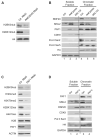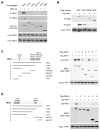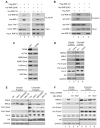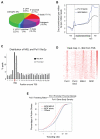H2B ubiquitylation promotes RNA Pol II processivity via PAF1 and pTEFb
- PMID: 24837678
- PMCID: PMC4065619
- DOI: 10.1016/j.molcel.2014.04.013
H2B ubiquitylation promotes RNA Pol II processivity via PAF1 and pTEFb
Abstract
Histone H2B ubiquitination plays an important role in transcription regulation. It has been shown that H2B ubiquitination is regulated by multiple upstream events associated with elongating RNA polymerase. Here we demonstrate that H2B K34 ubiquitylation by the MOF-MSL complex is part of the protein networks involved in early steps of transcription elongation. Knocking down MSL2 in the MOF-MSL complex affects not only global H2BK34ub, but also multiple cotranscriptionally regulated histone modifications. More importantly, we show that the MSL, PAF1, and RNF20/40 complexes are recruited and stabilized at active gene promoters by direct binary interactions. The stabilized complexes serve to regulate chromatin association of pTEFb through a positive feedback loop and facilitate Pol II transition during early transcription elongation. Results from our biochemical studies are underscored by genome-wide analyses that show high RNA Pol II processivity and transcription activity at MSL target genes.
Copyright © 2014 Elsevier Inc. All rights reserved.
Figures







References
-
- Bataille AR, Jeronimo C, Jacques PE, Laramee L, Fortin ME, Forest A, Bergeron M, Hanes SD, Robert F. A universal RNA polymerase II CTD cycle is orchestrated by complex interplays between kinase, phosphatase, and isomerase enzymes along genes. Mol Cell. 2012;45:158–170. - PubMed
Publication types
MeSH terms
Substances
Associated data
- Actions
- Actions
Grants and funding
LinkOut - more resources
Full Text Sources
Other Literature Sources
Molecular Biology Databases
